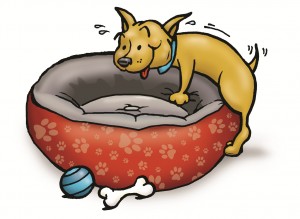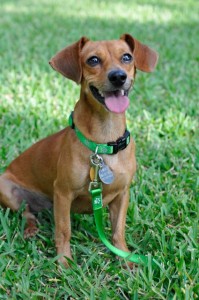Michael Baugh CPDT-KA CDBC
Lots of dogs hump. For people who live with those dogs, it can be embarrassing and upsetting. We humans aren’t comfortable talking about things related to sex, especially when our beloved dogs are being indiscreet in front of guests. For many of us, dogs are cute innocent “babies.” I guess now is a good time to remember they’re also animals, and animals routinely practice behavior related to their own survival. That includes sexual behavior: humping.
What baffles a lot of people is that dogs hump in situations that have nothing to do with reproduction. I have a client whose 4 month old female puppy humped a stuffed animal. We caught our dog Stewie humping his bed. Dogs hump human legs. Doggie daycare professionals deal with humping dogs all day, males and females, neutered and spayed. There seems to be no rhyme or reason to it. What’s going on here?
I asked trainer educator and author Jean Donaldson (The Culture Clash, Train Your Dog like a Pro). She zeroed in on Modal Action Patterns. Those are the behaviors all dogs share related to fighting, fleeing, feeding and reproducing. She said, “All of the Modal Action Pattern categories are present in play. That’s what play is.” Social animals, including dogs, routinely play fight and play chase. They even pretend to stalk and hunt, so we shouldn’t ignore the idea that humping might be play sex. However, that may not be the whole story of humping.
While humping is common in play groups and day care settings, it also occurs in other contexts. Some dogs hump people and inanimate objects. Sugarland Veterinary Behaviorist Dr. Lore Haug says most of the time humping is “merely a nonspecific sign of arousal.” Trainers and day care counselors agree. Dogs get wound up or nervous and they hump. Pamela Johnson is a Certified Professional Dog Trainer in San Diego. Her dog used to hump her leg during training sessions. She videotaped the behavior and noted that the humping was caused by excitement over training and frustration when the lesson got difficult. Still, identifying what sets off the behavior doesn’t fully answer the question: Why humping and why not some other behavior?
We should keep in mind that anything our dog does regularly is reinforced behavior. The dog is getting something out of it. For example, dogs who wrestle or chase during play are reinforced by other dogs who enjoy wrestling and chasing. Similarly, dogs might enjoy the attention they get for humping. Humping may also relieve a dog’s anxiety in an uncertain social situation. It may just be pleasurable. That pleasure, says Dr. Haug, “obviously would come under the sexual category.” So, we’re back to that uncomfortable subject. Regardless, all of this information leads us to some good ideas about stopping humping.
Make humping no fun and not a big deal. This really means we need to control our own behavior and not react when we see our dog humping. Don’t accidentally reinforce the behavior by freaking out.
Control the Dog’s environment. In the case of the client’s dog who was humping the stuffed toy and in the case of our own dog humping his bed, we simply removed the objects of their affection. People who work at doggie day care facilities calmly and gently remove a humping dog from its playmate. In all cases, the dog can’t practice the unwanted behavior anymore.
Teach the dog a better behavior. For the client’s dog and Stewie we replaced humping objects with more appropriate enrichment toys (Kong Toys and other treat puzzles). In daycare, counselors might direct a humping dog to a less disturbing play behavior. Trainer Pamela Johnson greatly decreased her dog’s humping by interrupting it and taking a short break from training. She held and petted her dog until he calmed down, then she returned to training less-frustrating tasks. In all cases, the handler is teaching the dog to do something other than hump.
That’s the bottom line really. Stay calm. Interrupt the humping. Encourage the dog to do something else, anything else. I might choose some of those other Modal Action Pattern behaviors, like a game of tug, or fetch, or even some nice quiet time with a chew toy. The humping one – not many of us really want to see our innocent little dogs doing that. Sure, it’s normal animal behavior. But don’t forget, we’re only human.
Houston Dog Trainer Michael Baugh specializes in fearful and aggressive dog training.


